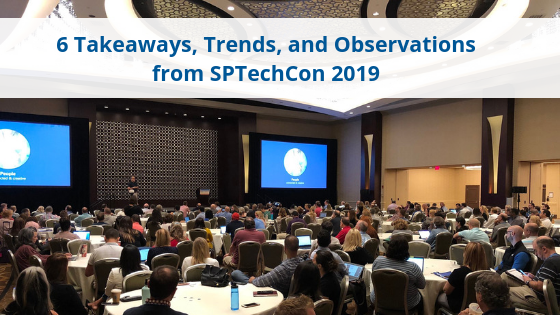sptechcon
6 Takeaways, Trends, and Observations from SPTechCon 2019


The successful completion of another SPTechCon Boston is under our belt.
As I like to do after these events, I stop and think about the people I talked to in the industry, the problems, and challenges they are encountering with various aspects of Office 365 tools and their businesses, plus what they hoped to achieve by attending the conference.
One of my main goals at SPTechCon is to speak with attendees and understand why they came to the event. Most people come with some problems or ideas and hope to get more direct-human feedback on technology issues.
Here are the big takeaways, challenges, and trends that I uncovered from conversations throughout the week:
Takeaways and Trends from SPTechCon 2019
1. Collaboration and Automation Are The Future
Microsoft Teams, Flow, PowerApps are the big winners over the past year and continue to lead today into the future. The desperate need for a powerful workflow engine to replace classic SharePoint features has put us in the driver’s seat to create real-world applications in SharePoint Online.
Microsoft Teams has been such a needed addition to the toolset that it’s no surprise how quickly it has taken off. Users have switched over almost entirely to this tool for communication and collaboration, relying on classic SharePoint features for more process-based on document and information management.
2. Change is Constant in the Office 365 Ecosystem
Office 365 users have a difficult time making sure their team (often a team of one) can keep track of the features being updated and introduced by Microsoft.
From small changes that derail a training exercise to whole new applications becoming available to an entire organization, changes to the platform are constant and can have a huge impact on how teams do business.
We, collectively, haven’t fully converted from the classic installation, service pack, and major revision model of yesterday. In the past, users and admins could review the release notes, understand the changes, test the installation, and release several feature changes on our schedule. Now, enhancements come in an unsteady stream.
This is a scary proposition to those who try to build and maintain the confidence of business while offering cutting edge capabilities.
It’s one of the reasons I publish the Timlin Office 365 Monthly Buzz Newsletter every month with updates, trends, and goings-on related to Office 365 and SharePoint. If you’d like to receive it, sign up here.
3. Understanding the Longer Microsoft Roadmap is Challenging at Best
Microsoft has never done a great job at helping us build a 3-5-year technology plan based on their feature and release roadmap – the guidance just isn’t cohesive enough.
For example, if we knew that InfoPath and Workflow were going to be abandoned and replaced with PowerApps and Flow, we could have planned for it in advance. Also, the new versions of these tools don’t have feature parity, so they aren’t completely compatible as replacements.
This is a frustrating proposition for CIOs and technology leaders to recommend a plan, not knowing if the technology will be abandoned, what its possible replacement may be, and if something else will take its place within 2-3 years.
The strategy, training, and political clout required to correctly implement these tools are too high to guess and hope.
4. Using Strategy and Governance Helps Identify the Right Tool(s) for the Job
The features in the Office 365 Suite contain several overlapping and interconnected capabilities. Organizations struggle to understand how set the proper guidance, support, and train people down a path they are comfortable managing.
When there are too many ways to manage tasks, it becomes almost impossible to severely limit the choices, so many organizations turn to a “free for all” approach. This methodology can increase initial user adoption, but almost always creates major problems if the platform takes off.
Organizations should consider when to use which tools and how to set the stage to provide solutions to their internal business problems in a well-orchestrated capacity. Information architecture, business analysis, governance, training, and ongoing support are all crucial to the success of user adoption and achieving digital transformation.
5. Guaranteeing Proper User Adoption Isn’t Easy
Hopefully, you are noticing a theme here. Most of these issues stem from similar problems. Without the time or resources, you often have one of two paths to choose, or possibly both paths at the same time:
- Pick and choose high-value problems/solutions and solve for those.
- Open the spigot and let people use the tools in whatever way works for them.
Both approaches have their pros and cons, but I talked to a lot of frustrated business analysts and administrators that were expected to make these tools useful for thousands of people with no help beyond their knowledge of the platform. This is not a good recipe.
6. Limited Time and Resources for Management and Maintenance are Commonplace
The obvious final piece of the puzzle is there isn’t enough time to make the impact these professionals want to make on their businesses.
For example, if an organization decides it needs a new ticket tracking system, it will create a team, spin up the plan, work it through to completion, provide training, support, and ongoing resources for management. They will then require that all new tickets come through this system, thus ensuring its viability.
When organizations start using Office 365, they treat it much differently. They bought it for email, Microsoft Office, and possibly OneDrive, and go into it assuming these are essentially desktop/individual tools.
The mindset and business approach to implementation are entirely different. Unlike a mandated/required ticketing system, many of the capabilities and solutions within Office 365 are not a pure requirement to complete work.
Instead, they are optional tools designed to create efficiency and error reduction. You must think ahead, build solutions, and entice or require people to perform certain activities within these tools to solve specific problems.
The Roadmap Ahead In The Office 365 Industry
As you will note from these takeaways, the world, and the businesses that thrive within it, are changing.
Where we used to work so hard to create process, efficiency, and predictability, the new methods of succeeding are based on adaptability, flexibility, and some bravery to embrace and accept that the world around will be adjusting a pace that we’ve never seen before.
Information (and misinformation) is given to the entire world in seconds, ideas, concepts, and features show up without warning.
The classic IT mentality has been tested and appears to be failing in a world that needs something different.
In conclusion, Office 365 and SharePoint continue to help organizations harness the power of technology to improve operational efficiency. As with any technology that has numerous, regular updates, it can be challenging to keep up, though, but it’s worth it.
Reach out if you need any help as our team is very well versed in all of Office 365’s tools and capabilities.

